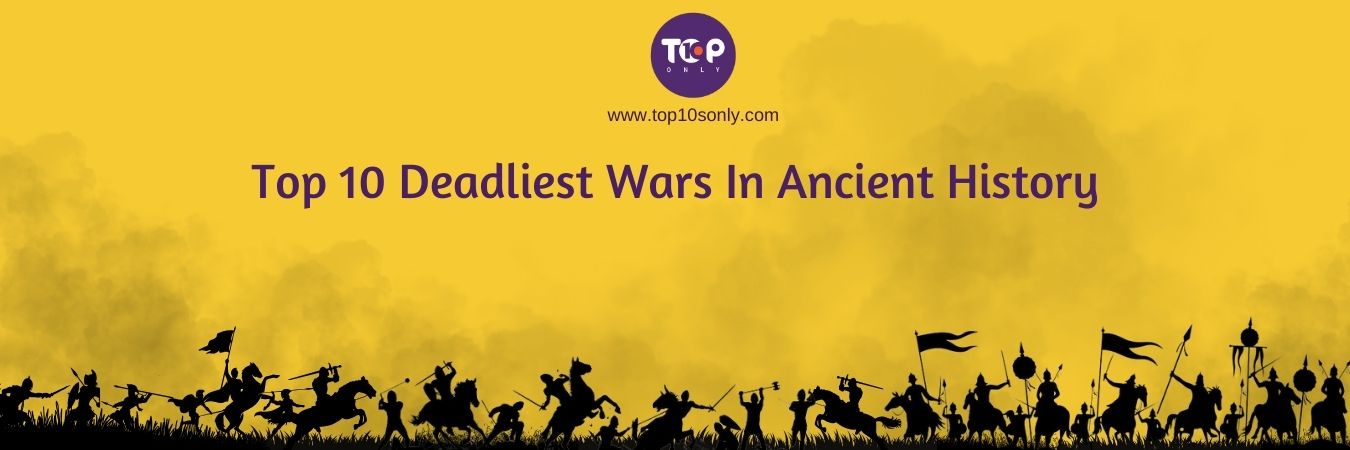
Ancient wars were the most devasting in history with their ruthless battle strategies and weapons of destruction, and tremendous loss of life. The biggest wars in ancient history were generally triggered by annexation, power conflicts, and resource extraction. The motives of these wars include territorial expansion, resource dominance, and their desire for political or religious supremacy. These deadliest wars not only moulded the outcomes of the conflict but also imprinted a legacy that steered the evolution of human history for future epochs. Here’s a glimpse into The Top 10 Deadliest Wars in Ancient History, handpicked by Top 10s Only exclusively.
Exploring The World’s Deadliest Wars In History
Warfare has been an essential aspect of human history, frequently influencing civilisations, boundaries, and cultural development. The deadliest battles in ancient history often involved ruthless warfare, substantial death rates, and great suffering for both combatants and civilian populations. In this article, we are committed to exploring the most catastrophic and deadliest wars in ancient history and their time period.
The List Of The Top Ten Most Deadliest Wars In Ancient History In Chronological Order
1. The Greco-Persian Wars (499 BCE – 449 BCE)
The Greco-Persian Wars are the earliest and the top deadliest wars in history. Often called the Persian Wars, these wars began with the Persian invasion of Greece, resulting in the Battle of Marathon. The causes of the wars originated from the Persian expansion. Wars were extremely devastating, with Greek deaths around 10,000 to 20,000 and Persian deaths ranging from 70,000 to over 100,000. Persia emerged from the wars because of its extensive resources. The conflict set the stage for Athens’s rise to power and finally thriving Greek civilization. The Greco-Persian Wars were pivotal in history because they safeguarded Greek political institutions and cultural legacy, which would transform the Western world.
2. The Nanda-Mauryan War (323 BCE – 321 BC)
One of the most deadliest wars waged in the world, The Nanda-Mauryan War marked a significant conflict in ancient India. It was centred around Chandragupta Maurya and Dhana Nanda. Chandragupta, under the guidance of Chanakya, defeated Dhana Nanda, slaying around 100,000 soldiers, 10,000 elephants, 100,000 horses and 5000 charioteers. The accurate timing of the conflicts remains uncertain. Eventually, the Mauryan Empire became the largest and most expansive empire in India. The newfound treasures of Dhana Nanda played a crucial role in establishing and expanding the Mauryan Empire, allowing Chandragupta to strengthen his rule and support military ventures. The war also paved the way for major political consolidation and cultural development in ancient India.
3. The Pyrrhic War (280 – 275 BC)
The Pyrrhic War was a conflict between the Roman Republic and Pyrrhus, the king of Epirus. Did you know that this is one of the most deadliest wars in the world and even brought about the phrase “Pyrrhic Victory”? Seeking the support of Greek city-states in Southern Italy, Pyrrhus achieved major victories at Heraclea and Asculum, yet endured significant losses, giving rise to the term ‘Pyrrhic Victory.’ The estimated death toll stands at approximately 50,000 to 60,000 from both sides collectively. The war strengthened Rome’s authority in the Mediterranean, enabling its subsequent growth.
4. The Punic Wars (264 BC – 146 BC)
One of the 10 most deadly wars in ancient history, the Punic Wars were a sequence of three conflicts with an estimated 1,250,000 – 1,850,000 deaths. It was fought between the Romans and Carthaginians. Each conflict had unique causes and consequences, with the final outcomes being Roman supremacy over the Western Mediterranean and the ultimate demise of Carthage. Carthage was completely destroyed, the people were enslaved, and the territory was integrated as a Roman province of Africa. The war equipped Rome with the expertise and financial strength to evolve from a small city into a powerful empire that would dominate the known world. The Punic Wars vastly extended Roman power and laid the foundation for its supremacy in the Mediterranean.
5. Kalinga War (262 BCE – 261 BCE)
Let’s start with one of the bloodiest wars in Indian history that inadvertently led to the rise of Buddhism in India—the Kalinga War. Kalinga’s crucial location and its resistance to surrender to Mauryan rule were perceived as hindrances to Ashoka’s empire expansion. Consequentially, it led to the deadliest war in Indian history, the Kalinga War. It was a remarkable and ruthless battle fought between Ashoka and the independent state of Kalinga. The battle was barbaric and led to a considerable loss of over 100,000 soldiers and civilians within a year. Despite victory, the destruction of war had a profound effect on Ashoka, who was engulfed in sorrow over human suffering. He renounced violence and embraced Buddhism. The war played a significant role in spreading Buddhism. The war, though devastating, initiated a new era of ethical leadership and religious tolerance in the Mauryan Empire, modelling the development of Indian history for generations ahead.
6. The Gallic Wars (58 – 50 BCE)
The Gallic Wars were one of the most important military campaigns in Roman history, fought between the Roman armies and various Gallic tribes. Thousands of Gallic tribes were killed, many enslaved and evicted, and the entire village was destroyed. The conquest of Gaul signified the end of Gallic self-governance and the beginning of their merger into the Roman world. It was a turning point in Caesar’s career and the history of Rome. They redefined the political and military framework and also contributed to the eventual transition of the Roman Republic to the Roman Empire. The outcome of the war generated vast riches. Gaul became an integral part of the Roman Empire, setting the stage for prolonged Roman control in the region. The conquest unlocked fresh opportunities for trade, resolution, and cultural integration. The Gallic Wars reinforced Caesar’s position as one of Rome’s greatest generals.
7. The First Jewish-Roman War (66 – 74 CE)
Sometimes called the Great Jewish Revolt, the First Jewish-Roman War was a significant uprising by Jews in Judea against Roman rule. The main cause was the tyrannical governance of Roman officials, the increasing divide between the affluent aristocracy and the downtrodden population, and the Roman Jewish religions. The revolt had a profound effect on the local population, resulting in the deaths of approximately 3,50,000 rebels. The conflict resulted in the destruction of Jerusalem and the Second Temple. The war marked the end of organised Jewish resistance against Roman rule in Judea.
8. The Three Kingdoms War (220 CE – 280 CE)
The Three Kingdoms War signified one of the deadliest turbulent times in Chinese history. It was a phase of vigorous battle between the three rival states—Wei, Shu, and Wu—all striving for control over China. The roots of the conflict lay in the decline of the Han Dynasty, which was undermined by corruption within the peasant revolt. The Three Kingdoms War is among the most deadliest wars by casualties. For decades, the three kingdoms fought in a succession of battles, killing more than 20 million people, but none could achieve firm dominance over the entire empire. Ultimately, Wei conquered Shu in 263, followed by Jin usurping Cao Wei in 266, and culminating in Jin’s conquest of Wu in 280. The Three Kings’ period was marked by widespread violence along with progress in culture and technology. It was one of the most glorified periods in Chinese literature, depicted in the novel “Romance of the Three Kingdoms”.
9. The Goguryeo-Sui War (598 CE – 614 CE)
One of the deadliest wars in Chinese history, the Goguryeo-Sui War, was a series of military conflicts between the Goguryeo Kingdom of Korea and the Sui Dynasty of China. In the battle of Salsa in 612 CE, the Sui suffered devastating losses to the strong opposition of the troops headed by General Eulji Mundeok. They lost nearly all their 305,000 mighty delegations. The war was deadly for the Sui Empire, ending in a sequence of failures and a notable decrease in manpower and finances. The war concluded in 614 with Goguryeo’s victory, forcing Sui China to abandon its ambitions, leading to the dynasty’s decline.
10. An Lushan Rebellion (16 December 755 – 17 February 763)
The An Lushan Rebellion, led by An Lushan, was the most ravaging revolt in history owing to its vast magnitude of devastation and loss of life. It began as a provincial uprising aiming to oust and displace the Tang government with the rebel Yang Dynasty. The rebels captured Chang’an (the imperial capital), bridged the regions of three Yang emperors—Xuanzong, Suzong, and Daizong—and marked a turning point in the history of mediaeval China. The An Lushan Rebellion is one of the most deadliest wars by death toll. It is regarded as one of the deadliest conflicts in history, with an estimated 13 to 36 million deaths. The decline in its power, economy, central control, and enormous loss of life marked the onset of the dynasty’s slow decline. The Rebellion not only resolved the substantial military confrontation but also initiated an era of deep transformation for the Tang Dynasty and Chinese history.
Impacts Of The Deadliest Wars In Ancient History
Wars have been a persistent part of human history, lasting across eras and shaping civilisations. These wars remind us of how destructive human conflicts can be, leaving deep scars on the world.
